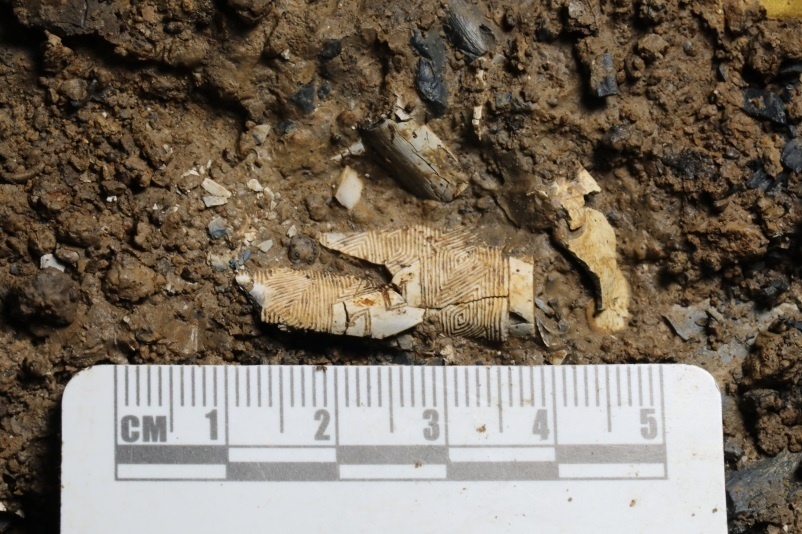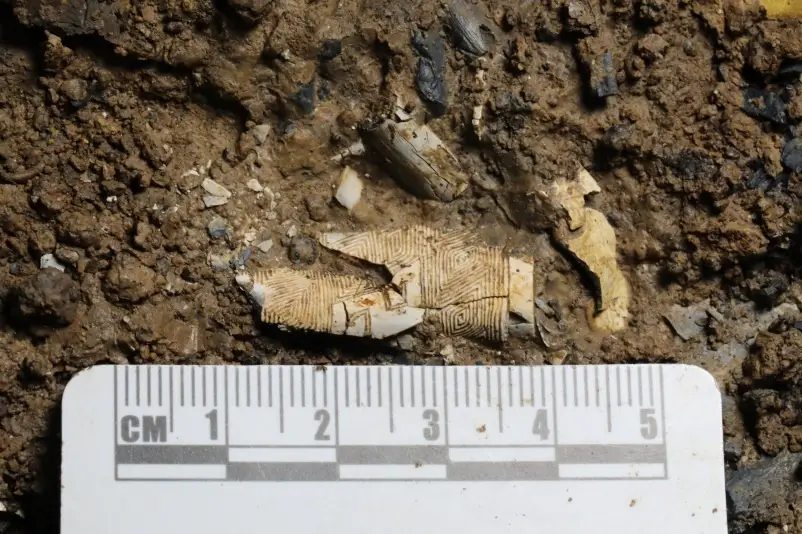By Yang Xuemei, Wang Mingfeng, Song Haoxin, People's Daily

Photo taken on Jan. 31 shows ivory carving relics unearthed from No. 5 sacrificial pit of the Sangxingdui Ruin, Guanghan, southwest China's Sichuan Province. (Photo courtesy of Sichuan Provincial Cultural Relics and Archaeology Research Institute)
Over 500 artifacts were unearthed in the six ancient sacrificial pits newly discovered in Sanxingdui Ruins in southwest China’s Sichuan Province between November 2019 and May 2020, including pieces of gold masks, bird-shaped gold pieces, and pieces of miniature ivory sculptures, said archaeologists during a meeting held in Chengdu, capital of Sichuan on March 20.
The historic site, located in Sichuan's Guanghan, is believed to be the remnants of the ancient Shu Kingdom dating back some 3,000 years to 5,000 years ago. It is hailed as one of the greatest archaeological findings in the 20th century. Discussions on it have never faded since the first two sacrificial pits were discovered in 1986.
Archaeologists practiced maximum protection over the Sanxingdui Ruins soon after the salvage excavation of the No.1 and No. 2 pits. The six newly discovered pits are similar with the No. 1 and No. 2 pits in terms of shape, structure, orientation and relics unearthed.
The six new pits and the two discovered in 1986 are all in the eastern part of the ancient Sanxingdui city, surrounded by small circular pits, rectangular grooves and large grooves related to sacrificial activities, introduced Lei Yu, a researcher with Sichuan Provincial Cultural Relics and Archaeology Research Institute who heads the excavation work at the Sanxingdui Ruins site. This means that the conclusions formed upon the relics unearthed in the 1986 pits and relevant archaeological activities have to go through new challenges and tests, he added.
This time, bronze heads with colored eyes, gigantic bronze masks, bronze statues, and bronze sacred trees were unearthed in the No. 3 pit of the Sanxingdui Ruins site. Besides, hundreds of ivories were also discovered, a part of which were burned and buried with jade and bronze ware items.
The discoveries this time are of milestone significance compared with those in 1986, as archaeologists made a new attempt to move advanced laboratories to the field, Lei said.
An emergency shelter was set up in the enclosures at the site with constant humidity and temperature to protect organic relics. The shelter was equipped with low-temperature and low-humidity cabinets, as well as low-temperature sample boxes, in which bones, horns, ivories, textiles, lacquerware and woodware can be protected.
Archaeologists also established another emergency shelter for inorganic relics, where gold pieces, bronze ware, jade and potteries could be protected by ion chromatography and extraction devices. Besides, excavation data and videos were also recorded and transmitted. These techniques guaranteed synergetic excavation and protection, multi-discipline integration and multi-party collaboration.
Sun Hua, professor with Peking University noted that the excavation this time wasn't just about unearthing relics, but also discovering, with technological means and theoretical models, how these relics were buried, so as to help archaeologists gain a better understanding of the layout of the sacrificial zone of the Sanxingdui Ruins.
The academic world has never ceased its studies on Sanxingdui civilization over the past three decades, raising a series of questions and conducting plenty of discussions, said Song Xinchao, deputy director of the National Cultural Heritage Administration.
"Today, we have a clearer picture of the history of the Chengdu Plain, and are well prepared both academically and technically, so we are able to carry out multi-discipline cooperation," he said. He also extended a warm welcome to foreign archaeologists to jointly study the Sanxingdui civilization that brings both challenges and surprises.
The historic site, located in Sichuan's Guanghan, is believed to be the remnants of the ancient Shu Kingdom dating back some 3,000 years to 5,000 years ago. It is hailed as one of the greatest archaeological findings in the 20th century. Discussions on it have never faded since the first two sacrificial pits were discovered in 1986.
Archaeologists practiced maximum protection over the Sanxingdui Ruins soon after the salvage excavation of the No.1 and No. 2 pits. The six newly discovered pits are similar with the No. 1 and No. 2 pits in terms of shape, structure, orientation and relics unearthed.
The six new pits and the two discovered in 1986 are all in the eastern part of the ancient Sanxingdui city, surrounded by small circular pits, rectangular grooves and large grooves related to sacrificial activities, introduced Lei Yu, a researcher with Sichuan Provincial Cultural Relics and Archaeology Research Institute who heads the excavation work at the Sanxingdui Ruins site. This means that the conclusions formed upon the relics unearthed in the 1986 pits and relevant archaeological activities have to go through new challenges and tests, he added.
This time, bronze heads with colored eyes, gigantic bronze masks, bronze statues, and bronze sacred trees were unearthed in the No. 3 pit of the Sanxingdui Ruins site. Besides, hundreds of ivories were also discovered, a part of which were burned and buried with jade and bronze ware items.
The discoveries this time are of milestone significance compared with those in 1986, as archaeologists made a new attempt to move advanced laboratories to the field, Lei said.
An emergency shelter was set up in the enclosures at the site with constant humidity and temperature to protect organic relics. The shelter was equipped with low-temperature and low-humidity cabinets, as well as low-temperature sample boxes, in which bones, horns, ivories, textiles, lacquerware and woodware can be protected.
Archaeologists also established another emergency shelter for inorganic relics, where gold pieces, bronze ware, jade and potteries could be protected by ion chromatography and extraction devices. Besides, excavation data and videos were also recorded and transmitted. These techniques guaranteed synergetic excavation and protection, multi-discipline integration and multi-party collaboration.
Sun Hua, professor with Peking University noted that the excavation this time wasn't just about unearthing relics, but also discovering, with technological means and theoretical models, how these relics were buried, so as to help archaeologists gain a better understanding of the layout of the sacrificial zone of the Sanxingdui Ruins.
The academic world has never ceased its studies on Sanxingdui civilization over the past three decades, raising a series of questions and conducting plenty of discussions, said Song Xinchao, deputy director of the National Cultural Heritage Administration.
"Today, we have a clearer picture of the history of the Chengdu Plain, and are well prepared both academically and technically, so we are able to carry out multi-discipline cooperation," he said. He also extended a warm welcome to foreign archaeologists to jointly study the Sanxingdui civilization that brings both challenges and surprises.
 Menu
Menu
 Over 500 relics found in prehistoric Sanxingdui Ruins in SW China
Over 500 relics found in prehistoric Sanxingdui Ruins in SW China
















